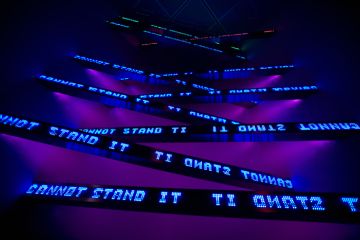
Paddy Johnson interviewed Jenny Holzer for New York Press about her new show at the Whitney Museum of American Art in New York City (it opened yesterday, March 12).
Titled PROTECT PROTECT, the exhibition is packed into one floor of the Upper East Side museum and shows a selection of Holzer’s work from the last two decades.
Art21 released a new video on Holzer this week, featuring the outdoor Xenon Projections of PROTECT PROTECT in Chicago. Watch it here and view the others released earlier this year here and here.
Following is a short excerpt from an information-packed interview that covers the technical execution of Holzer’s works, her thoughts about the curation of text and the role of intuition in her art:
Paddy Johnson: You’ve talked about how you like your work to be socially useful. In your opinion, what are the more useful capacities art can serve today?
Jenny Holzer: A translation is that I want to be useful somehow to justify my existence. I don’t think that art has to be useful, at least not in any straightforward way. I don’t want art in service. But good art can be responsive, alive to and so truthful about what’s around, and that’s potentially helpful. Being awestruck, dumbstruck and transfixed by art can be dandy. And being aroused, stunned, terrified, lulled, intrigued, confounded, freed, schooled and euphoric is a lot, and art can do that and more.
PJ: Indexable text on the Internet has created both the desire and need for textual curation. Has this influenced your practice in any way?
JH: Since I stopped writing, I’m always pulling text off the web and trying to put it in order so that I can give collections to people.The Redaction, Hand and Map paintings at the Whitney are a result of this activity. I searched for declassified and other sensitive material on the war in Iraq and the treatment of detainees in hopes of understanding more about what happened, then I silk-screened the pages that seemed most representative and telling. Often I chose first-person accounts because the “I” stays alive and helps me understand and reply to the history. And to my surprise, I’ve been picking images sometimes rather than text, so that the stories can be glimpsed rather than read. I’m working on the installation of these paintings for the Whitney and am finding that the hanging can reflect the original searches at times and that’s interesting.
Read the whole interview here.



